First Races on the Long Island Motor Parkway: The 1908 Motor Parkway Sweepstakes
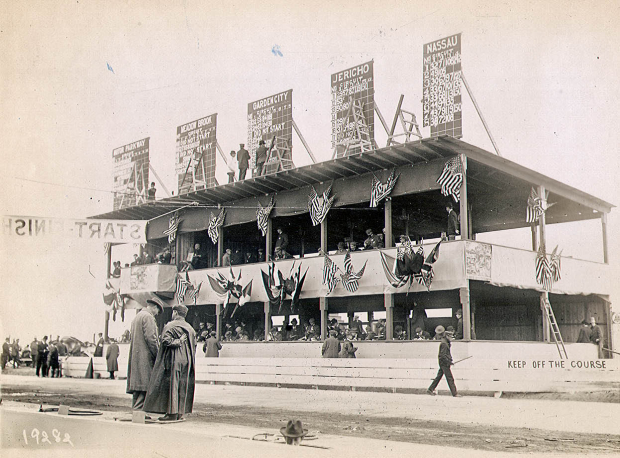
When the Long Island Motor Parkway was completed in October 1908, the first race using the completed 9 miles of the road was not the 1908 Vanderbilt Cup Race, but a series of five concurrent races called the Motor Parkway Sweepstakes. The story of these races and photo highlights are featured in today's post.
Enjoy,
Howard Kroplick
Motor Parkway Sweepstakes
On September 10, 1908, the Vanderbilt Cup race commission revealed plans to christen the first completed section of the Long Island Motor Parkway with five stock car races ran concurrently in “Sweepstakes Races.”
This event was scheduled for October 10, 1908, the opening day of the Long Island Motor Parkway. The Sweepstakes Races would provide an opportunity to test the new course, timing systems and crowd control for the Vanderbilt Cup Race that would be run two weeks later.
The cars in the Sweepstakes Races were classified by their sales price. Entries were divided into five categories :
• Motor Parkway Sweepstakes: cars selling for over $4,000.
• Garden City Sweepstakes: cars selling between $3,001 and $4,000.
• Meadow Brook Sweepstakes: $2,001 to $3,000.
• Jericho Sweepstakes: $1,000 to $2,000.
• Nassau Sweepstakes: cars selling for under $1,000.
The race commission issued an official statement, saying, “In order to open the Long Island Motor Parkway with an automobile event which will be in keeping with the fastest race course in the world the William K. Vanderbilt Jr. Cup Commission has set aside the elimination race…and substituted The Motor Parkway Sweepstakes.”
When the 1908 Vanderbilt Cup Race course was announced on August 1, 1908 it included 11 miles of the Long Island Motor Parkway, but by the time practice for the Sweepstakes Races began in October, the Motor Parkway only accounted for 9 miles. The total distance for the entire course, originally planned for 28 miles, proved to be shorter as well, eventually coming in at 23.46 miles.
The course was designed for speed. Not only were hopes high that the concrete paving of the Motor Parkway would produce startling lap times, but the rest of the course would as well. Dubbed the “the plateau racing drome” by A.R. Pardington, the route presented few hills and better than half of it was on a downgrade.
Practice for the Sweepstakes Races, the curtain raiser of Long Island Motor Parkway racing, began Tuesday, October 6, 1908. The teams started their runs at daybreak with the understanding that they could not run at speed after 7 a.m. without penalty.
The Sweepstakes Races had attracted 33 entries and the first practice day saw 12 of the cars take to the course. Among that number were four Mitchells, three Stoddard-Daytons and three Buicks. Lewis Strang’s stock Renault and a Simplex rounded out the 12 racers.
Wednesday, October 7 saw 20 cars explore the course, and again, no one tested their limits of speed. Among the cars running on Wednesday was a Vanderbilt Cup entry from Thomas and Strang’s Renault. Strang was entered in both the Vanderbilt Cup Race and the Motor Parkway Sweepstakes in two different Renaults. One was a stock car, the other a specially built racer.
There were only three good practice sessions the entire week before the Sweepstakes races. Few cars had achieved full speed, slowed by road repairs or early morning fog. The real test for the competitors and the Motor Parkway would come with its first races and the official opening of the Parkway.
The Motor Parkway Sweepstakes Races
The 9 a.m. start for the Sweepstakes Races on Saturday, October 10, 1908 changed the nature of activities the night before from previous Vanderbilt Cup Races or American Elimination Trials. There was no need for people to camp or drive through the night to meet a pre-dawn start time. In fact, Automobile Topics reported that the Sweepstakes was “but the ghost of that classic event,” the Vanderbilt Cup Race.
Some hypothesized that attendance at the event was sharply lower than expectations because of the later start time from previous Vanderbilt Cup Races. In fact, The Automobile suggested that the later hour “did not appeal to the sporty crowd, which liked an excuse to make a night of it.”
Whatever the reason, the expected crowds did not materialize. Several special trains the Long Island Railroad had “steamed up” and had ready to transport hoards of people were not needed.
Automobile traffic moved freely, people in touring cars traveling down the Motor Parkway from the tollgates drove into the area and parked along the borders of the road to watch the races. Bridges filled with cars, providing a terrific vantage point for those parked there.
The new grandstand, no longer the temporary structure of rough wood planks from previous years, but a steel and cement edifice capable of seating 5,000 people, never came close to filling. Motor Age described the situation, saying, “The crowd was swallowed up by the monster stand.”
The slim crowd at start-finish, a traditionally large gathering, was judged to be lacking largely due to the remote location of the Hempstead Plains grandstand, the later start, and the fact that other vantage points from around the course were free of charge. Thousands of people and hundreds of cars had gathered at choice locations on the county roads that made up the rest of the course.
At 8 a.m. the flamboyant Starter Fred Wagner arrived, donning what one newspaper described as a “flaring green” handkerchief. Purple cloth hung from the front of the both the grandstand and the officials stand on the other side of the Parkway. Both also sported shields and flags of all the motor racing nations. Large American flags fluttered atop the roofs of the two stand structures. A northerly wind chilled the spectators, officials and newspapermen and everyone moved about if for no other purpose but to stay warm.
As people arrived, AAA and ACA officials mingled, giving evidence that their disputes had been set aside. ACA Chairman Robert Morrell was seen chatting cordially with his AAA counterpart, Jefferson De Mont Thompson. ACA Secretary Sam Butler managed the team of timers and newspaper accounts noted his dedication and alacrity.
Wagner lined the 33 starters in rows of two, in order of their starting positions. The least expensive cars were to start first, leading up through the five classes of automobiles. The car classifications were designated with a letter next to the number of the car with “N” for Nassau, “J” for Jericho, “G” for Garden City, “M” for Meadow Brook and “P” for Parkway. Odd numbered cars were in a line at the inside of the course, the even numbered cars were closest to the grandstand.
As the 9 a.m. starting time neared, Wagner, Sam Butler and timing expert Charles Dieges, who toted a big ship’s chronometer in a wooden box, prepared to spend the next 23 minutes launching the Motor Parkway’s inaugural race. They stood beside the first starter, Nassau Sweepstakes driver Ward Olney, who seconds later drove a Mitchell over the horizon. The remaining seven cars in the four-lap, 93.84-mile Nassau Sweepstakes followed in 30 second intervals.
After all the Nassau cars were released, Wagner delayed another minute until 9:05 a.m. before unleashing the first of the Jericho Sweepstakes machines. Six machines were entered in this contest for cars priced at $1,000 to $2,000. This race was for six laps or 140.76 miles.
Up next were the seven $2,001 to $3,000 Garden City cars, which were sent into the fray at 9:10 a.m. As with all the drivers, Wagner counted down the final 10 seconds and then slapped Stoddard-Dayton driver A.R. Miller on the back and shouted, “Go.” The Garden City Sweepstakes was an eight-lap race totaling 187.68 miles.
The nine lap, 211.14 mile Meadow Brook Sweepstakes was up next. The time was 9:15:30 a.m. This race only involved four cars as Louis Chevrolet in the Cleveland failed to start. On his way to the starting line he tangled with a touring car and slipped into a ditch. His team was unable to extract the machine from this predicament until well after all the cars were underway.
The big event of the day, the ten lap, 234.6 mile Motor Parkway Sweepstakes Race started at 9:20 a.m. This contest set up an interesting confrontation between the two most noteworthy drivers entered, Herb Lytle and Lewis Strang, both driving cars of foreign manufacture.
Strang had been on a tear in 1908, winning important stock car road races at Savannah, Georgia; Briarcliff, New York and Lowell, Massachusetts. He won all these races driving an Italian Isotta, but had recently switched to Paul LaCroix’ French Renault.
The race-winning Isotta was now in the capable hands of Herb Lytle. As with all the departures, men cranking their motion picture cameras crowded around to focus on Starter Fred Wagner, the drivers and the machines as exhaust smoke billowed about them.
Lytle and Strang ended the first lap in a dead heat for the lead overall on elapsed time even though both were in the middle of the pack of 33 cars crossing start-finish. Charles Basle’s big Knox was a full 29 seconds further back in third place.
Speculation before the start of the Sweepstakes Races had it that one of the bigger cars would overhaul all the little Nassau entries during the initial lap and return to the grandstand first. It was not to be. Buick number N-3, driven by Hugh Easter, earned the distinction of being the first to lead a competition lap of the new Motor Parkway course. Another Nassau car followed next, with Ward Olney at the wheel of the Mitchell that had started first.
Meanwhile, on the second floor of the officials stand there was a moment of panic among the timing officials. They were unaccustomed to the unprecedented number of cars, clusters coming in rapid succession and in different classifications at the end of lap 1. Two officials, Hank Caldwell and A.B. Tucker kept their wits about them and read their scoring record aloud to help everyone, including the press, get their bearings.
By the end of lap 3, Lytle not only extended his lead to about 3.5 minutes over Strang, but also passed everyone on the course and was the first to complete the lap. Lytle’s only pit stop of the day came on lap 7 and subsequently injected some excitement into the contest as Strang cut his lead from nearly 11 minutes to 6 minutes, 28 seconds. Some reports had Strang’s Renault only trailing the leading Isotta by 4 minutes at one point during the lap.
Lytle pitted his bright red Isotta in front of the grandstand for fuel and water at the end of the lap. The team got a rise out of the crowd by demonstrating some innovation. Lytle used a giant funnel larger than his gas can. After inserting the huge funnel into the gas tank he simply turned the big can upside down in it and then went to work inspecting his tires and engine.
One of Lytle’s strongest competitors at the start, Charles Basle, fell away on lap 7. His big Knox developed an unsolvable carburetor malady.
By lap 8, Lytle padded his lead over Strang by a minute, pulling more than 7 minutes ahead. He maintained his one lap advantage over Willie Haupt’s Chadwick, Frank Lascault’s Simplex and the Itala of Gus Lechleitner.
Just before 1 o’clock Lytle drove his bright red Isotta past Fred Wagner’s checkered flag to set a new American record for long-distance speed contests. His Long Island Motor Parkway Sweepstakes winning speed was an impressive 64.25 miles per hour covering the 234.6 miles in 3 hours, 39 minutes and 10 seconds. The previous American road racing record was Victor Hemery’s 61.40 miles per hour average in winning the 1905 Vanderbilt Cup Race. Lytle’s pace put him 11 minutes and 15 seconds ahead of Strang in the white and gray Lacroix Renault.
Much was made of Lytle’s speed and consistency. While no other driver turned a lap under 22 minutes during the races, Lytle averaged 21:55 at 64.25 miles per hour. The directors of the Long Island Motor Parkway Corporation were particularly anxious to provide evidence their vision and labor had borne fruit with a fast, safe speedway. Lytle’s success bolstered their position.
Lytle’s pace was all the more remarkable when he finished his ten laps before some of the competitors in the Jericho, Garden City and Meadow Brook Sweepstakes had completed their races of six, eight and nine laps respectively. The last driver to finish his race was Willie Haupt in the Chadwick, also in the Motor Parkway Sweepstakes, who required 4 hours, 27 minutes and 57 seconds to get the job done.
Five of the seven Motor Parkway Sweepstakes cars finished the race. Only the Knox and the Hotchkiss retired from competition early. In the other races, Hughie Hughes (Allen-Kingston) won the Meadow Brook Sweepstakes; W.H. Sharp (Sharp-Arrow) won the Garden City Sweepstakes; W.R. Burns (Chalmers) won the Jericho Sweepstakes and Hugh Easter (Buick) came first in the Nassau Sweepstakes. Unlike previous Vanderbilt races, officials were able to hold in check spectators wishing to run or drive out onto the track after the winner’s finish.
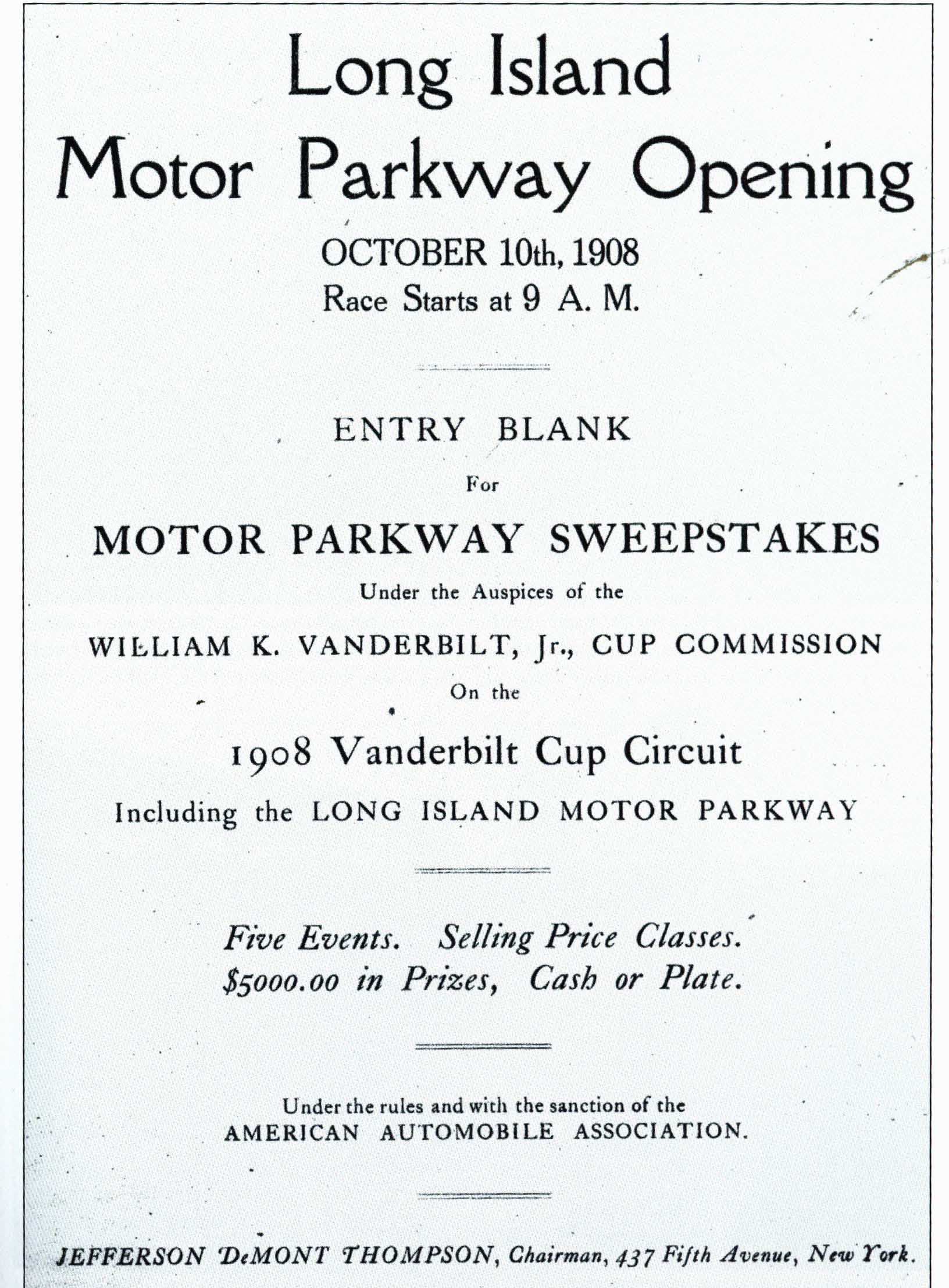
Even though it is announced that the Motor Parkway opened for business on October 10, 1908, there are no indications that festivities were held in conjunction with that long awaited day. The occasion was simply rolled into and made part of the sweepstakes races held that day. (Courtesy of the Suffolk County Vanderbilt Museum.)
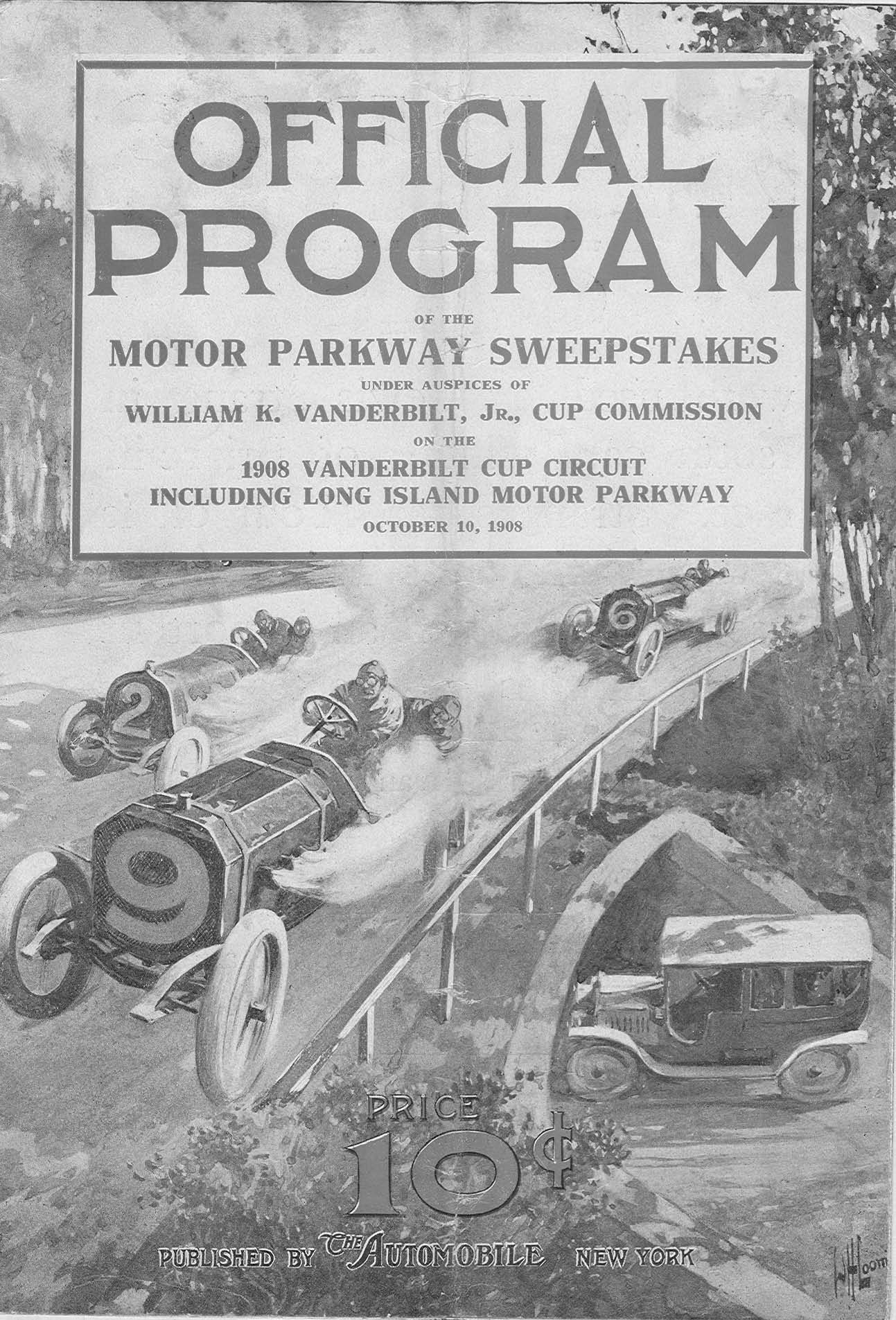
As described in the official program, these contests would provide an opportunity to test the new Motor Parkway course, timing systems and crowd control for the Vanderbilt Cup Race which was scheduled two weeks after the sweepstakes. The program cover cleverly highlighted one of the main features of the Parkway, the elimination of grade crossings.
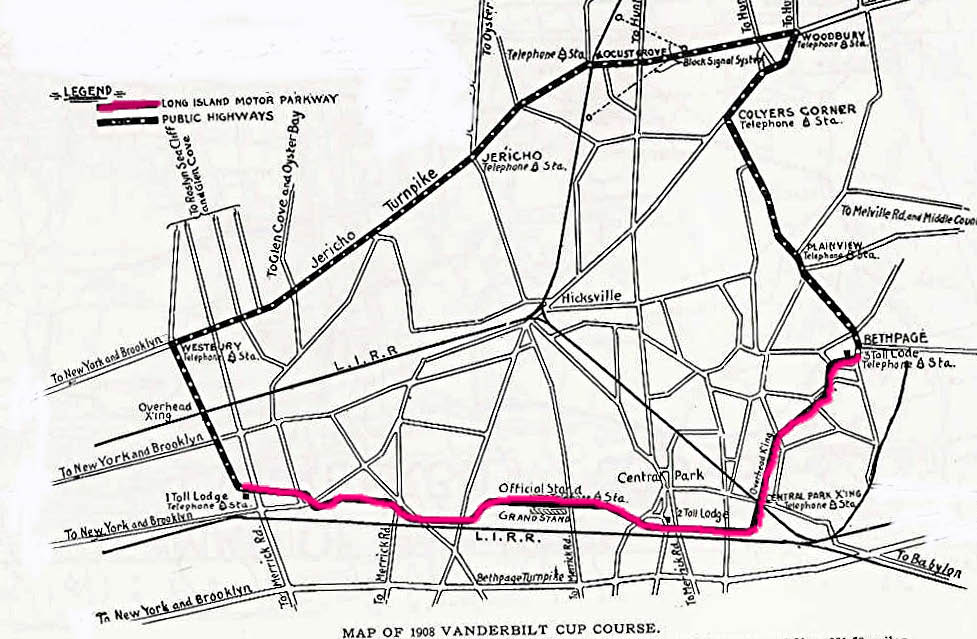
The 1908 Motor Parkway Sweepstakes course was the same as the Vanderbilt Race course. The 9-mile section of the Motor Parkway is highlighted in red. The remainder of the course was 14.46 miles of public roads; primarily Round Swamp Road, Plainview Road, Jericho Turnpike, and Ellison Road. (Courtesy of the Suffolk County Vanderbilt Museum.)
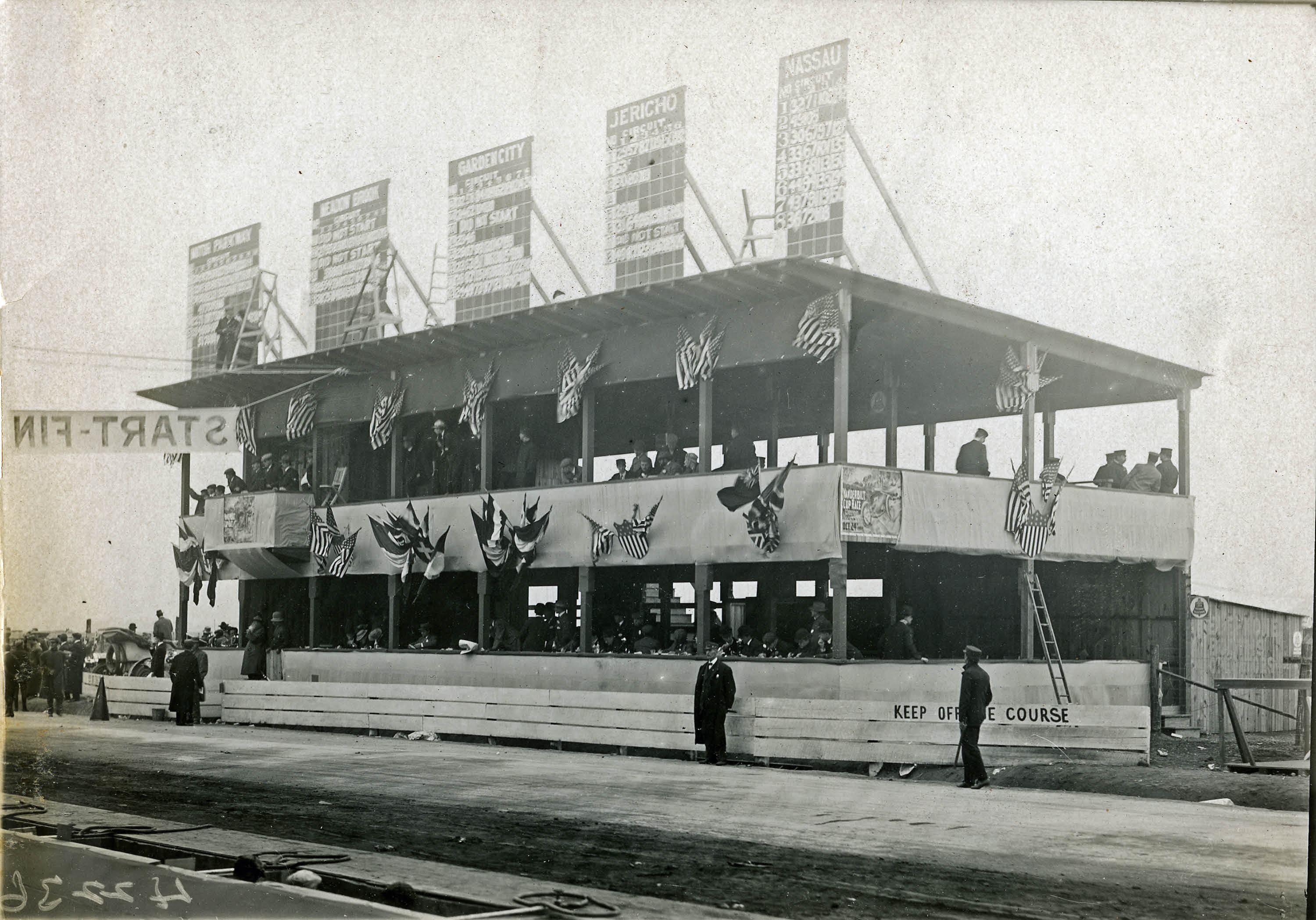
A newly built double-decker press and officials’ stand was located opposite from the grandstand. Scoreboards on top of the stand kept track of the five races. (Courtesy of the National Automotive History Collection at the Detroit Public Library.)
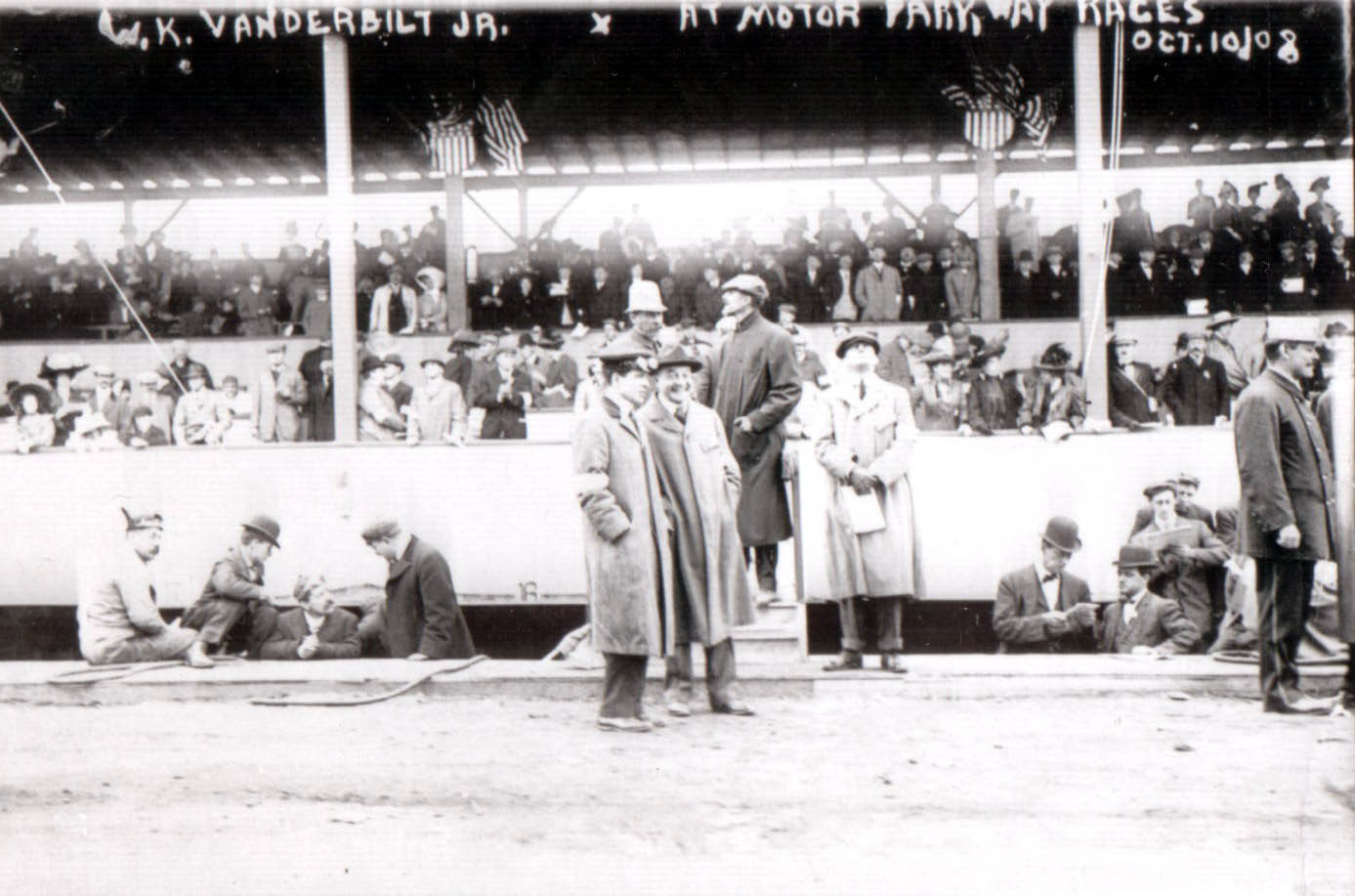
William K. Vanderbilt, Jr., center wearing the goggles, was the race referee. Note the pits for the service teams for the racers.
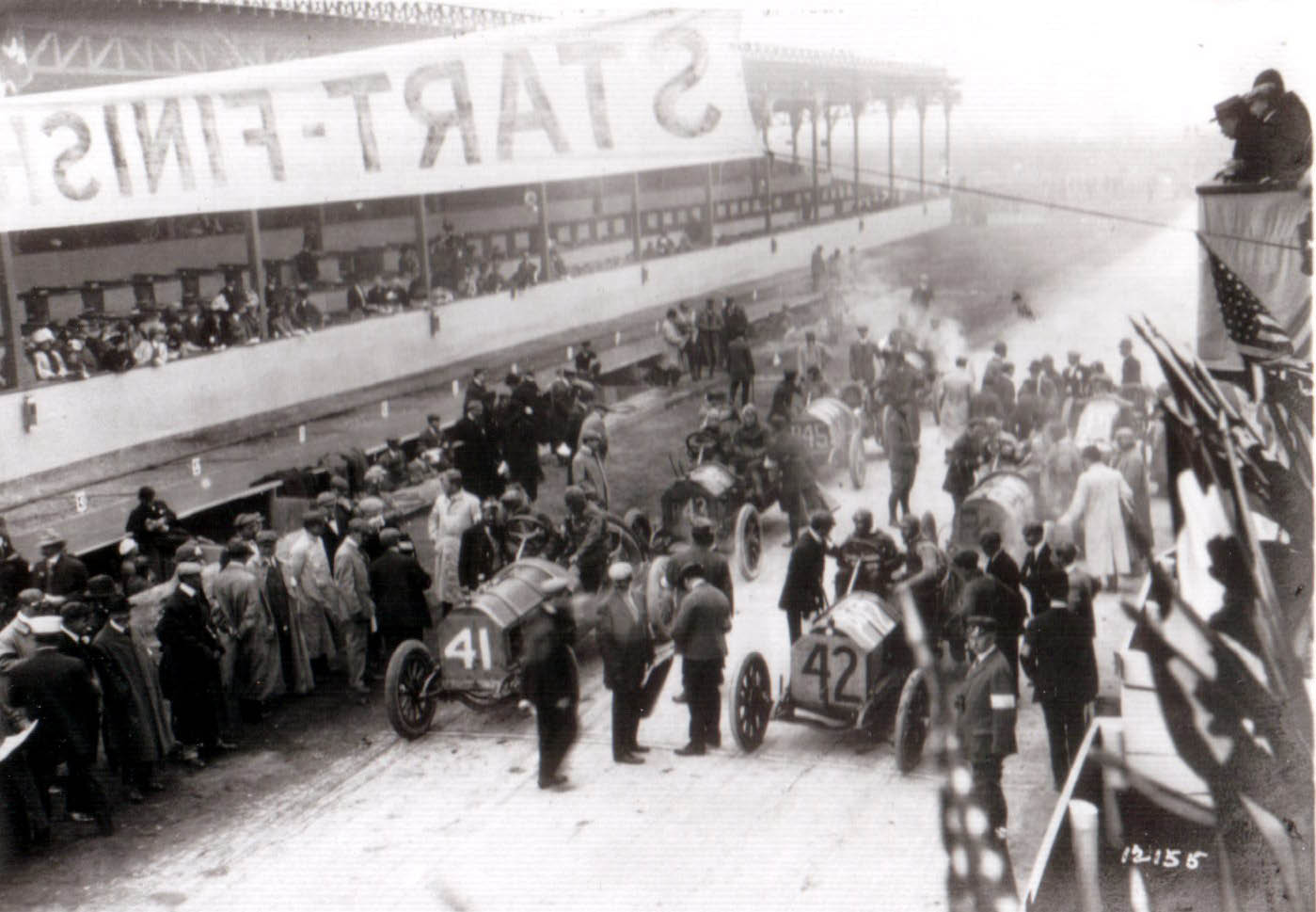
Starter Fred Wagner aligning the 32 race cars for the sweepstakes races in rows of two in front of the grandstand on the south side of the Motor Parkway, the site located today between Crocus Lane and Skimmer Lane in Levittown. (Courtesy of the Suffolk County Vanderbilt Museum.)
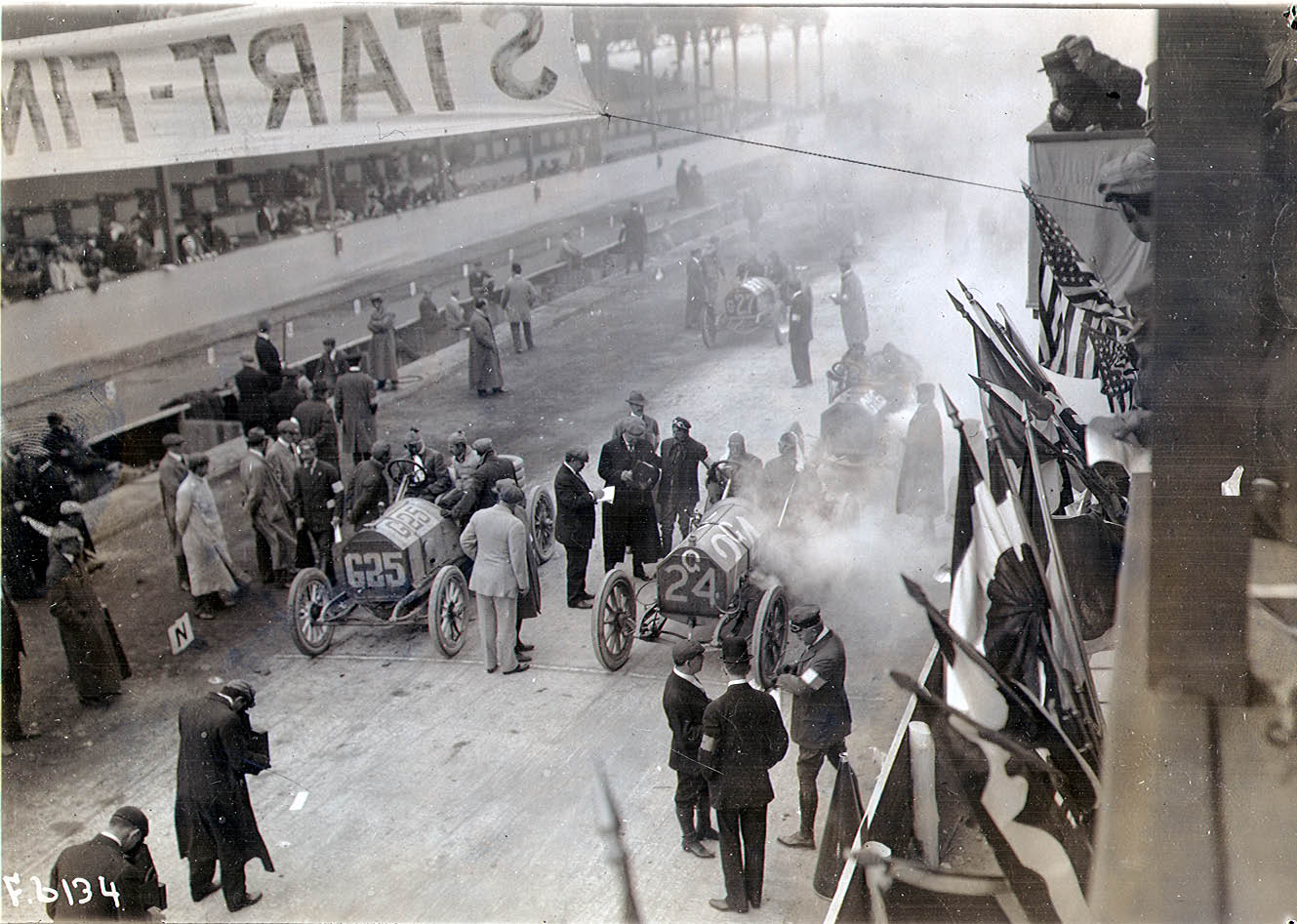
The Garden City Sweepstakes "G" racers at the starting line.
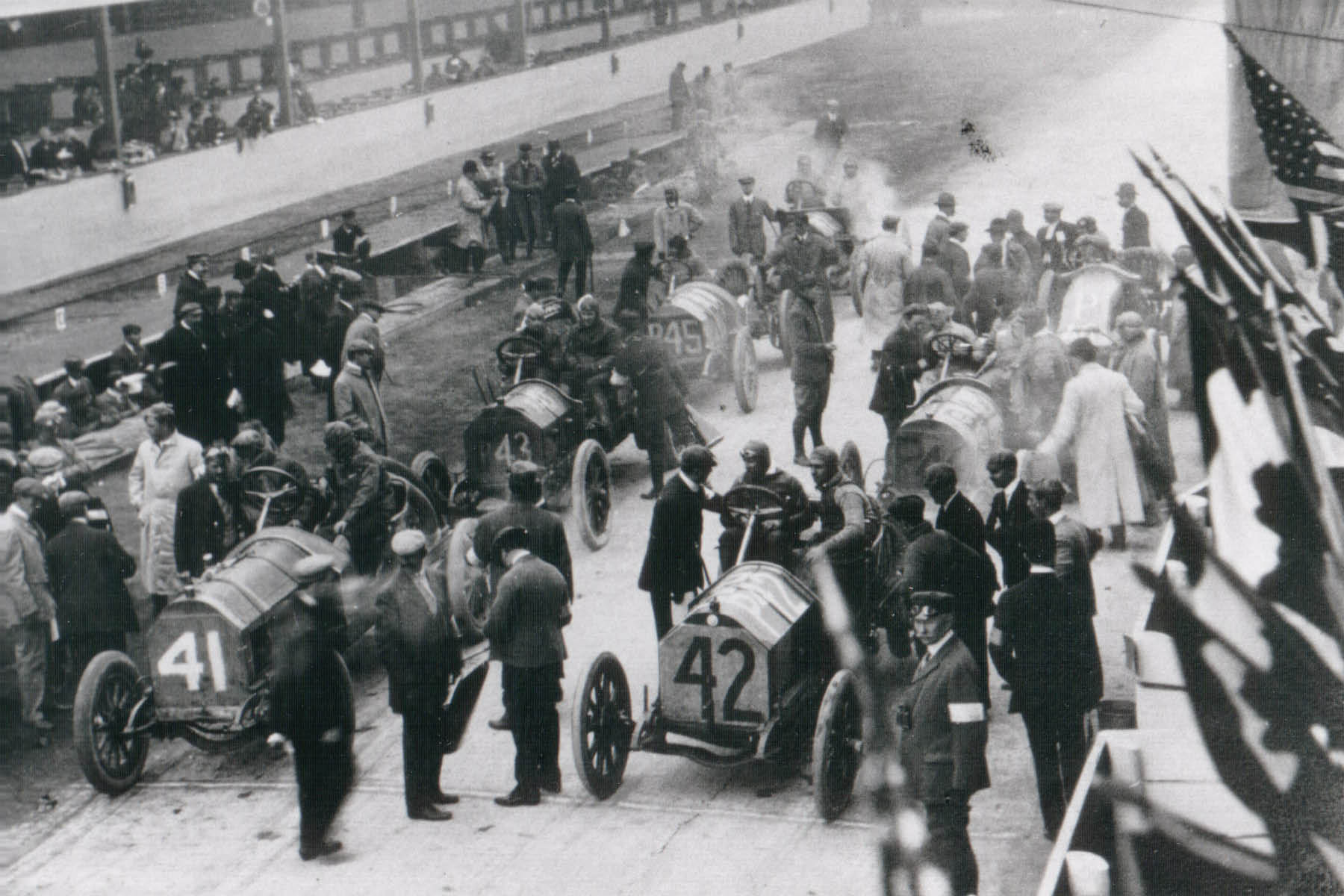
The large Motor Parkway Sweepstakes "P" racers at the starting line.
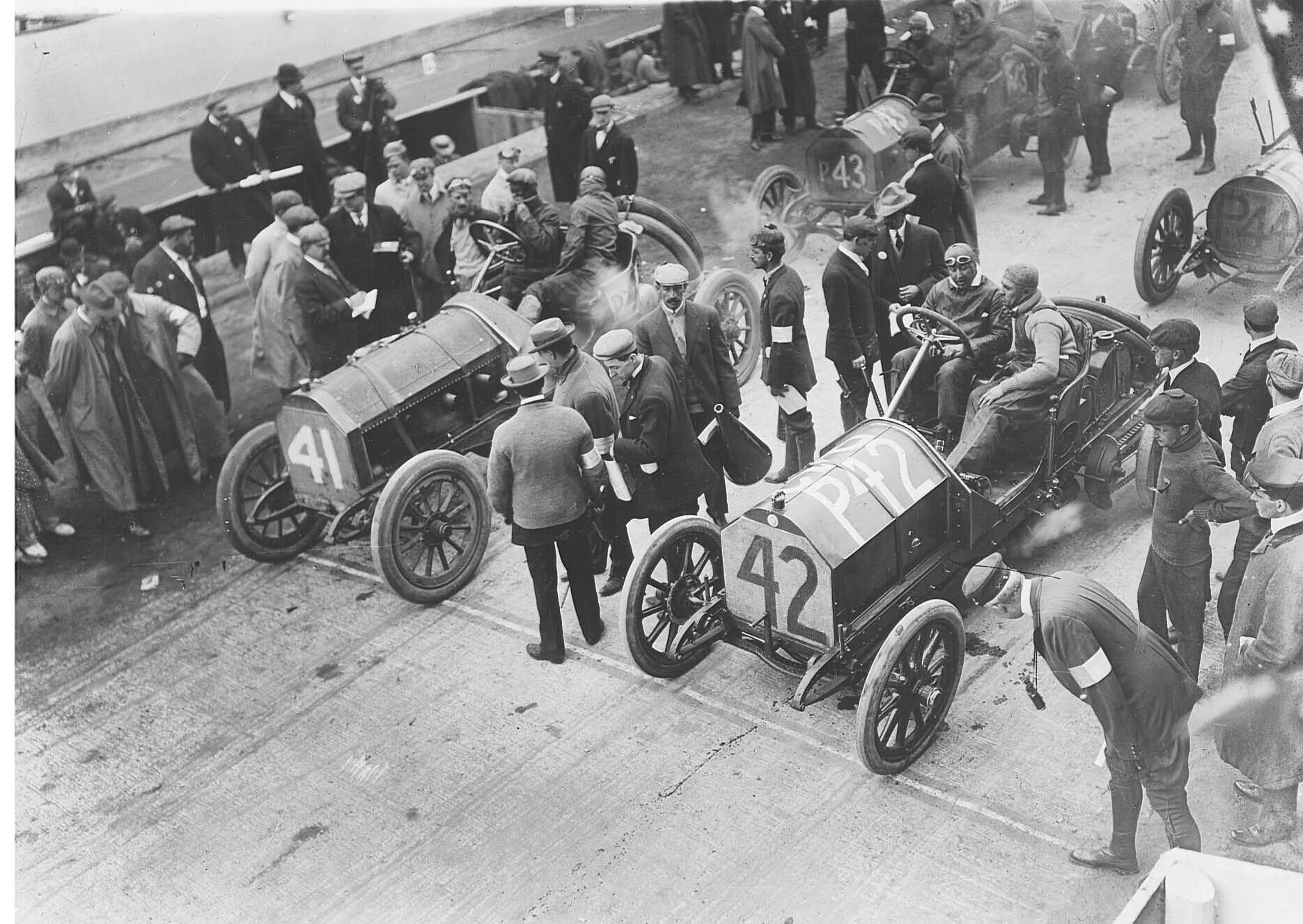
A close of of the #P41 Chadwick driven by William Haupt and the #P42 Isotta driven by Herb Lytle. Both cars would compete two weeks later in the Vanderbilt Cup Race.
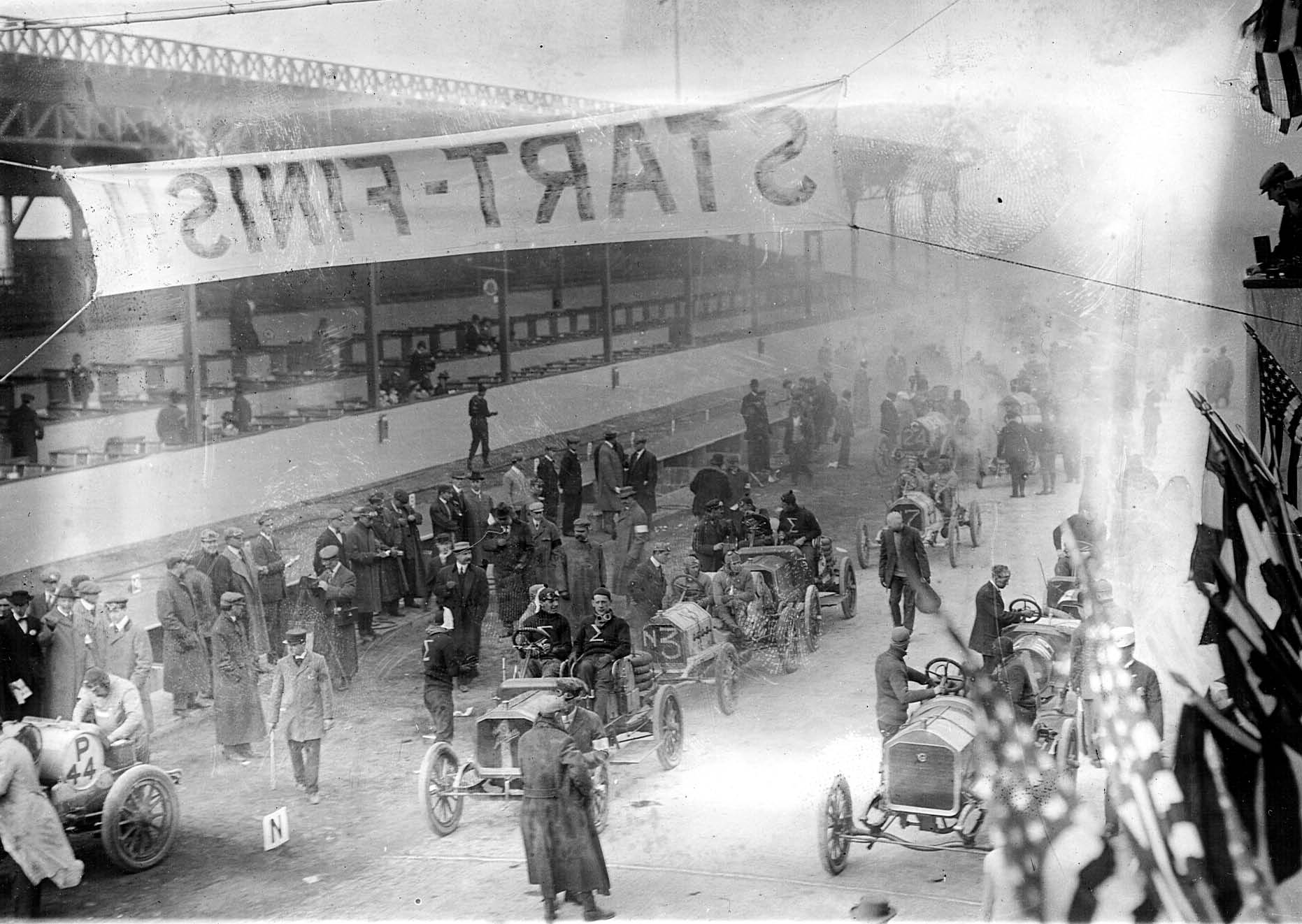
The Nassau Sweepstakes "N" racers at the starting line.
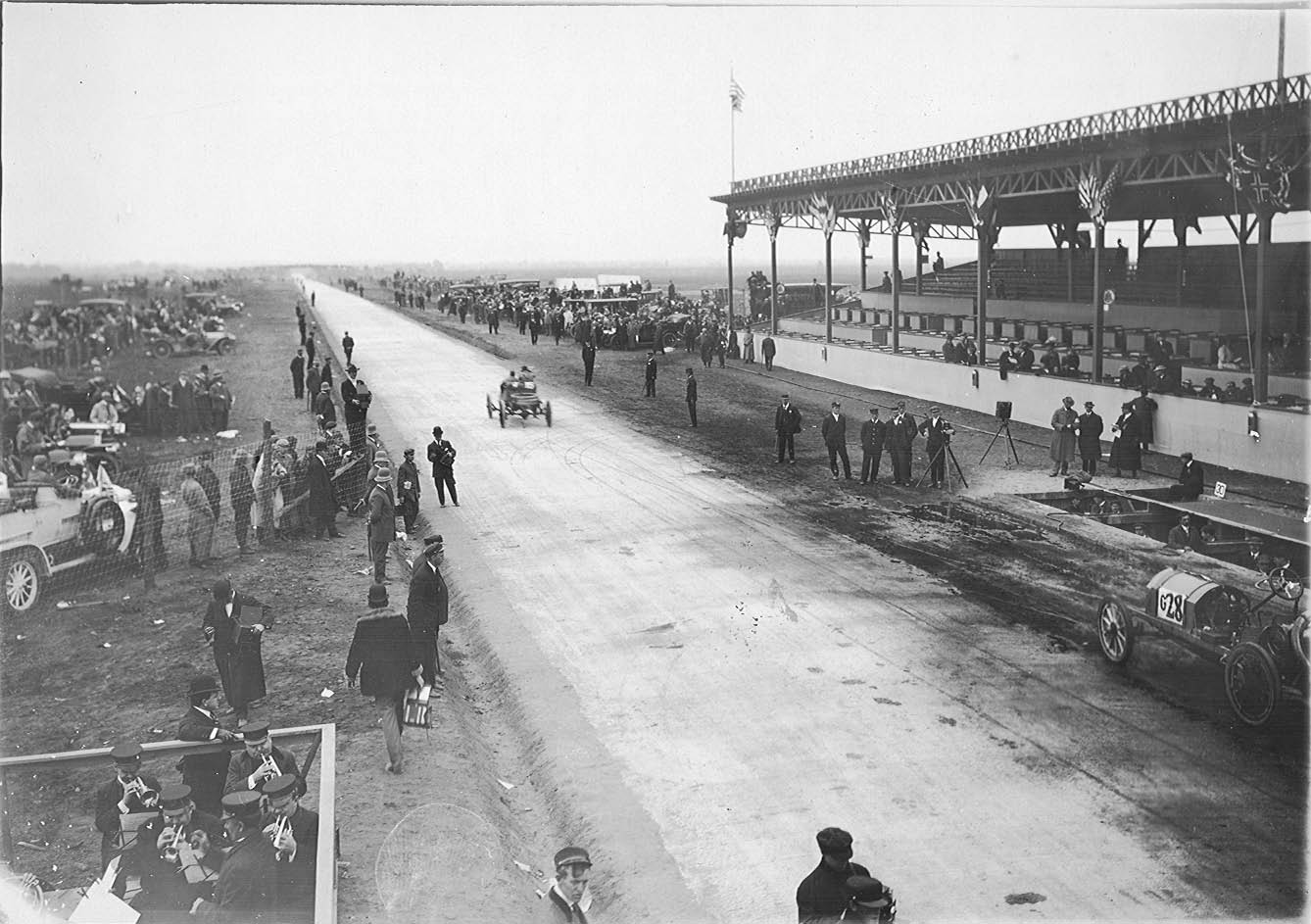
In conjunction with the building of the Motor Parkway, a grandstand was constructed for the Vanderbilt Cup Races. With a capacity of 5,000 spectators, the structure loomed large over the flat Hempstead Plains, visible for miles. At the start of the sweepstakes races, a band played music to a less-than-filled grandstand (Courtesy of the National Automotive History Collection at the Detroit Public Library.)
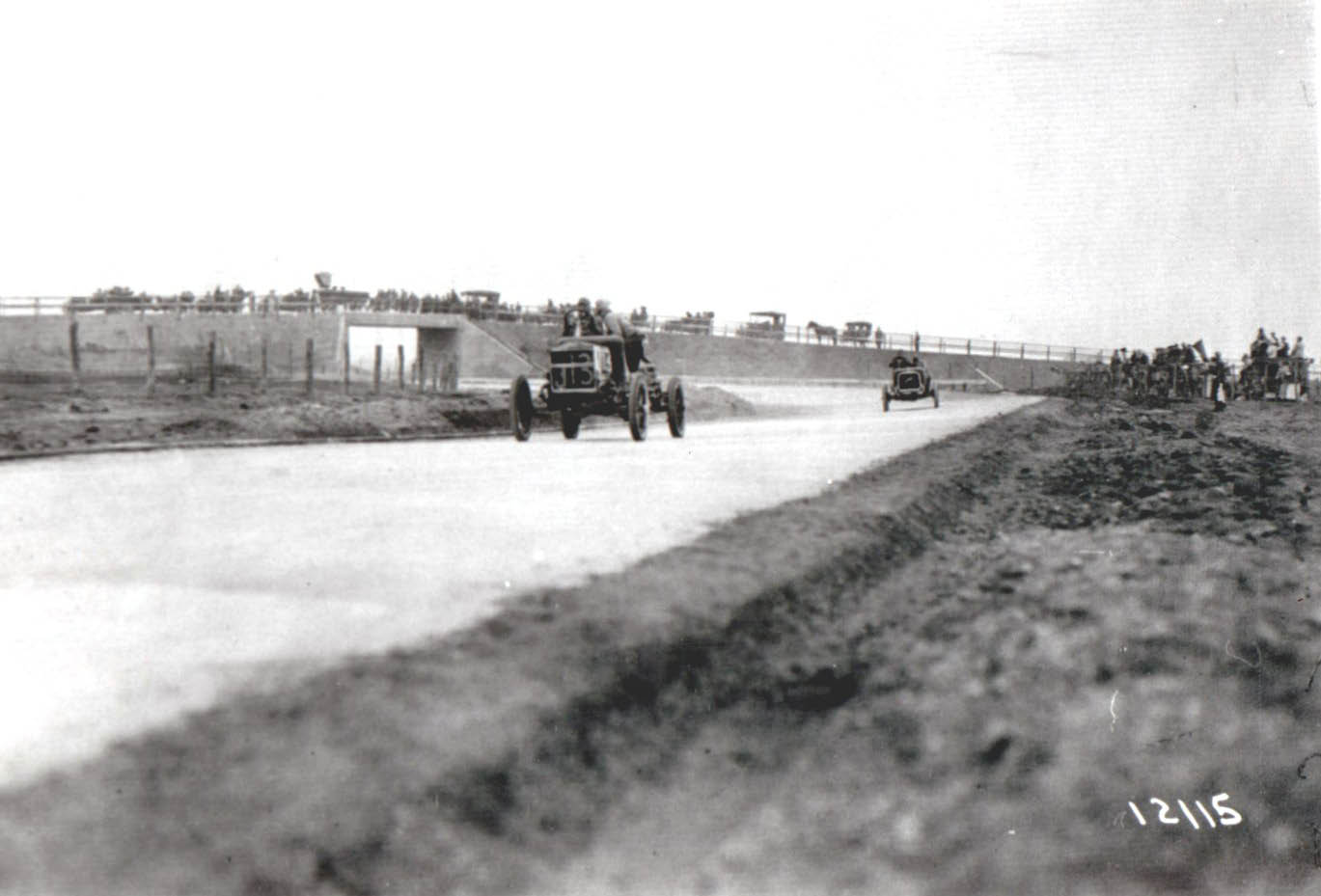
The No. J13 Maxwell battled the No. N5 Mitchell in East Meadow. Note the spectators, automobiles and horse-drawn carriages atop the Carman Avenue Bridge. (Courtesy of Suffolk County Vanderbilt Museum.)
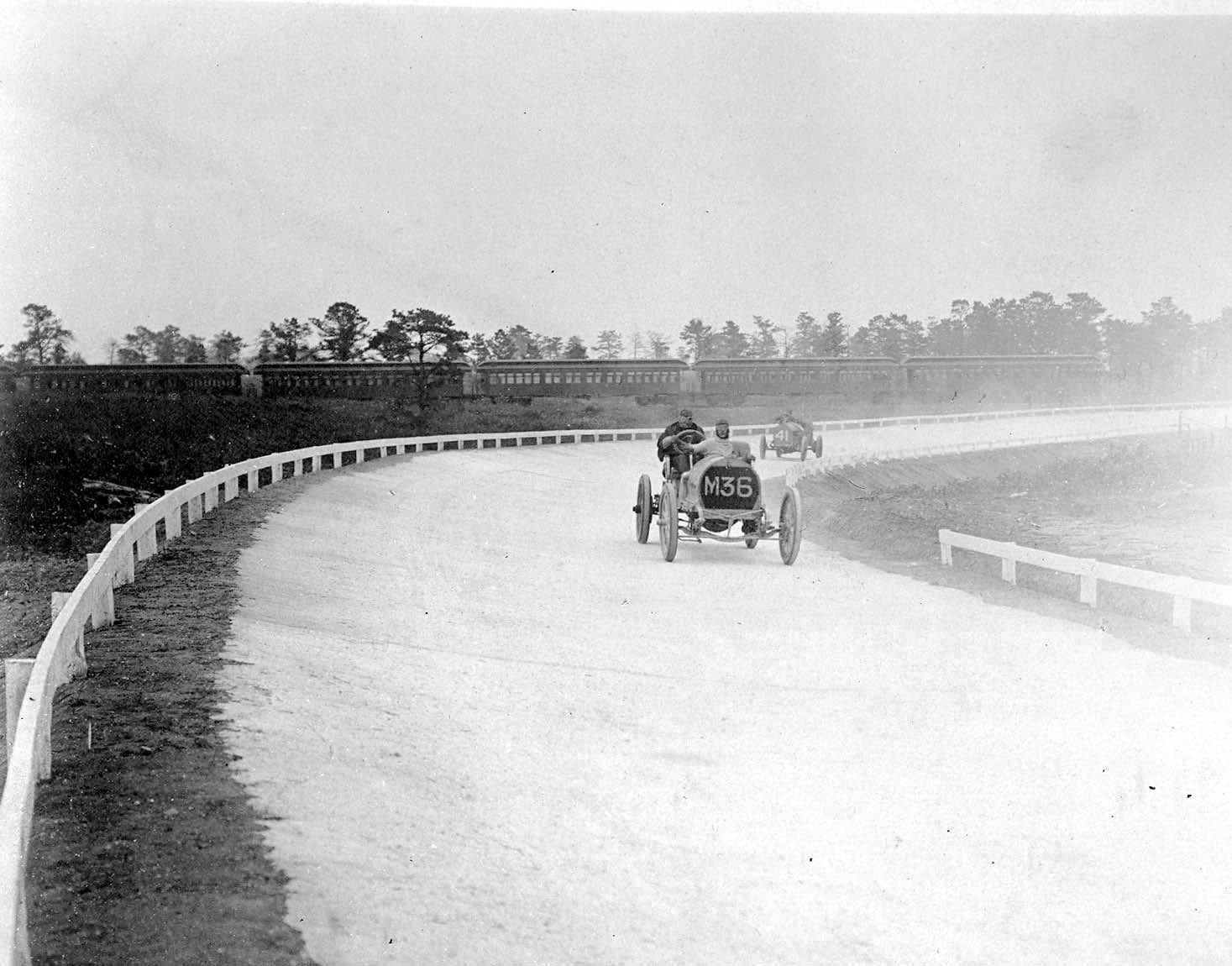
The #M36 Rainier battled the #P41 Chadwick through a “Deadman’s Curve” in Central Park, now Bethpage. In the background a line of race special commuter cars of the Long Island Rail Road on the tracks of the Central Railroad division line can be seen. The LIRR would run a number of these specials on race days as many of the spectators came out from the city by railroad. (Courtesy of Suffolk County Vanderbilt Museum.)
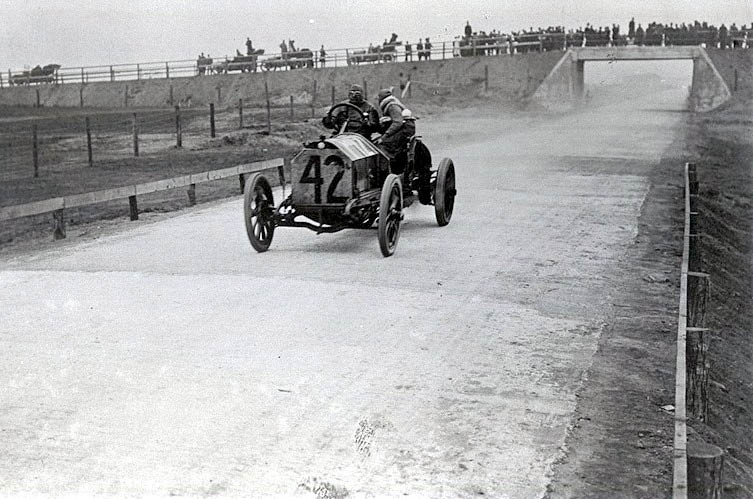
The winner of the Motor Parkway Sweepstakes was Herb Lytle driving his Isotta at an average speed of 64.25 mph, an American record for long-distance speed contests. As Lytle drove past the newly constructed Jerusalem Road Bridge over the Motor Parkway, his riding mechanician looked back towards the grandstand. The grandstand could be seen through the bridge passageway. (Courtesy of the Suffolk County Vanderbilt Museum.)
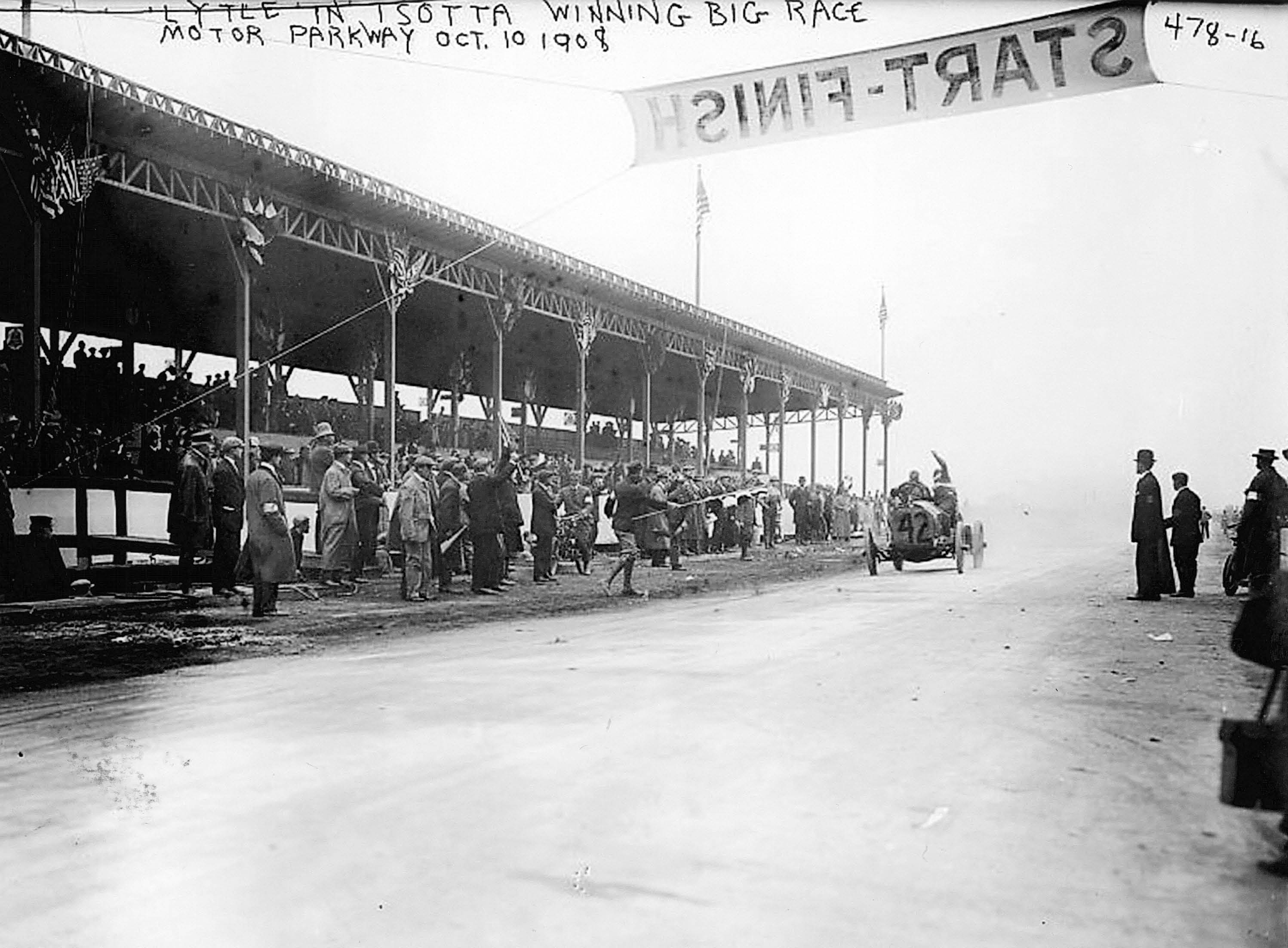
Herb Lytle taking the checkered flag from starter Fred Wagner.
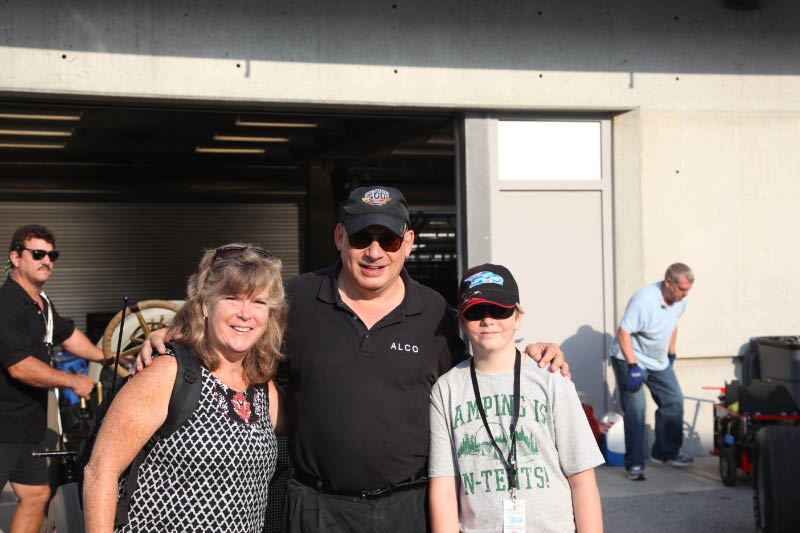
At the May 26, 2012 Legends' Day at the Indy 500, Herb Lytle's granddaughter Kate Quigley and her son paid a visit to the Black Beast.







Comments
From Michael Cook:
“Howard-
To this day, I am not certain how I came to be on your mailing list but I am certainly glad it happened. I enjoy every mailing for one reason or another. Some of the photos are amazingly sharp.
It would be wonderful if every historic racing venue had its own Howard Kroplick. Keep it up!
Mike Cook
Editor, Jaguar Journal and The Vintage Triumph
Wayne, NJ